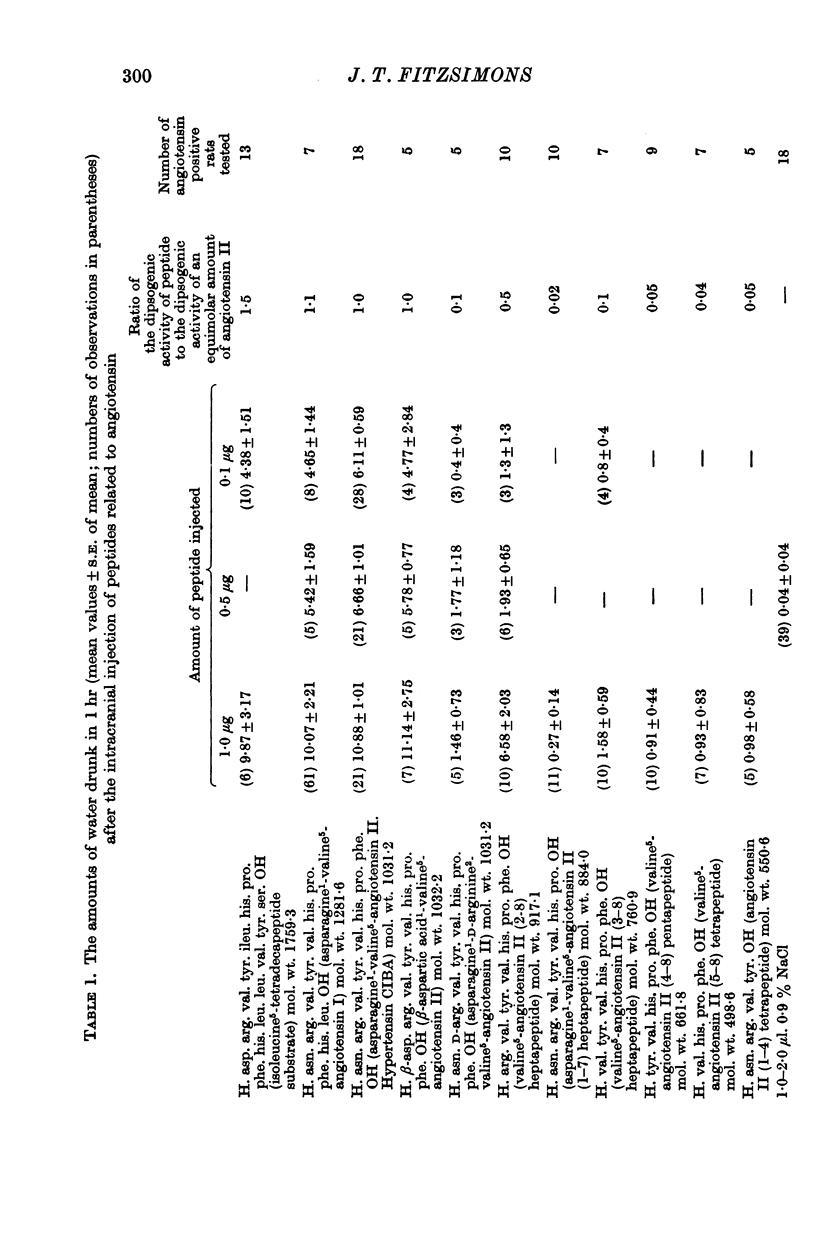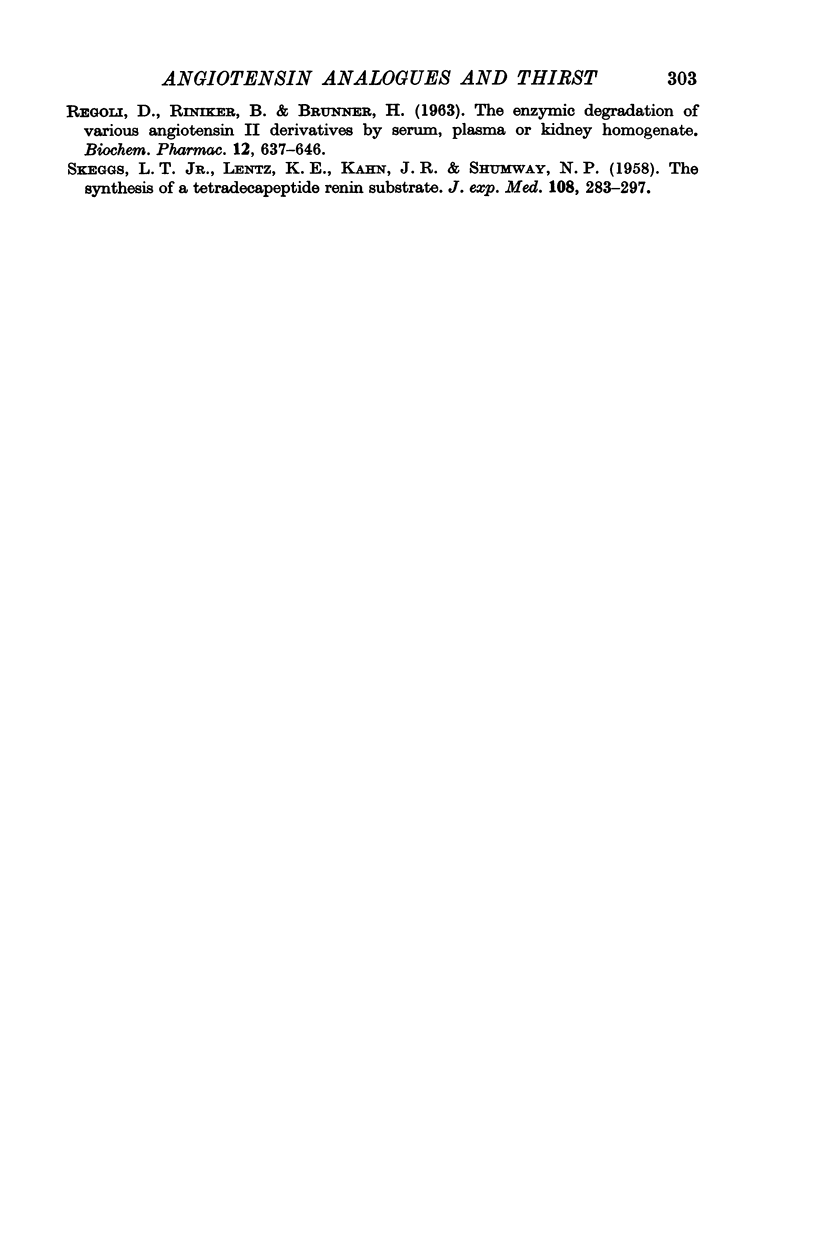Abstract
1. Recently it has been shown that injection of angiotensin II into the anterior diencephalon causes the rat to drink water. In the present experiments the dipsogenic action of a number of other substances including substances related to angiotensin was tested.
2. Injection of 0·001 Goldblatt u. renin into the angiotensin-sensitive region causes the water-replete rat to drink. Drinking is slower in onset and continues for longer than after injection of angiotensin II.
3. Synthetic tetradecapeptide renin substrate and angiotensin I were as effective as angiotensin II at causing water-replete rats to drink.
4. β-aspartic acid1-valine5-angiotensin II was also fully effective; but the D-arginine substituted octapeptide was much less effective.
5. The (2-8) heptapeptide retained about 50% of the dipsogenic activity of the octapeptide, whereas the absence of phenylalanine at the other end of the peptide chain in the (1-7) heptapeptide results in an inactive compound.
6. The (3-8) hexapeptide and the (4-8) pentapeptide, both of which have phenylalanine at the end of the chain, and the (1-4) and (5-8) tetrapeptide fragments of angiotensin II showed only a slight action on intake of water.
7. Kallikrein, bradykinin, adenosine-3′5-cyclic phosphate, vasopressin and oxytocin caused no drinking when injected into the angiotensin-sensitive region.
8. It is concluded that the requirements for the dipsogenic activity of angiotensin are the same as those for its other biological actions with the qualification that the precursor peptides are also active, presumably because they give rise to angiotensin II locally.
Full text
PDF








Selected References
These references are in PubMed. This may not be the complete list of references from this article.
- Aiken J. W., Vane J. R. The renin--angiotensin system: inhibition of converting enzyme in isolated tissues. Nature. 1970 Oct 3;228(5266):30–34. doi: 10.1038/228030a0. [DOI] [PubMed] [Google Scholar]
- Epstein A. N., Fitzsimons J. T., Rolls B. J. Drinking induced by injection of angiotensin into the rain of the rat. J Physiol. 1970 Sep;210(2):457–474. doi: 10.1113/jphysiol.1970.sp009220. [DOI] [PMC free article] [PubMed] [Google Scholar]
- Fitzsimons J. T., Simons B. J. The effect on drinking in the rat of intravenous infusion of angiotensin, given alone or in combination with other stimuli of thirst. J Physiol. 1969 Jul;203(1):45–57. doi: 10.1113/jphysiol.1969.sp008848. [DOI] [PMC free article] [PubMed] [Google Scholar]
- GOULD A. B., SKEGGS L. T., Jr, KAHN J. R. THE PRESENCE OF RENIN ACTIVITY IN BLOOD VESSEL WALLS. J Exp Med. 1964 Mar 1;119:389–399. doi: 10.1084/jem.119.3.389. [DOI] [PMC free article] [PubMed] [Google Scholar]
- Leary W. P., Ledingham J. G. Inactivation of angiotensin II analogues by isolated perfused rat liver and kidney. Nature. 1970 Jul 11;227(5254):178–179. doi: 10.1038/227178a0. [DOI] [PubMed] [Google Scholar]
- Ng K. K., Vane J. R. Conversion of angiotensin I to angiotensin II. Nature. 1967 Nov 25;216(5117):762–766. doi: 10.1038/216762a0. [DOI] [PubMed] [Google Scholar]
- Ng K. K., Vane J. R. Fate of angiotensin I in the circulation. Nature. 1968 Apr 13;218(5137):144–150. doi: 10.1038/218144a0. [DOI] [PubMed] [Google Scholar]
- PAGE I. H., BUMPUS F. M. Angiotensin. Physiol Rev. 1961 Apr;41:331–390. doi: 10.1152/physrev.1961.41.2.331. [DOI] [PubMed] [Google Scholar]
- PEART W. S. THE RENIN-ANGIOTENSIN SYSTEM. Pharmacol Rev. 1965 Jun;17:143–182. [PubMed] [Google Scholar]
- SKEGGS L. T., Jr, LENTZ K. E., KAHN J. R., SHUMWAY N. P. The synthesis of a tetradecapeptide renin substrate. J Exp Med. 1958 Sep 1;108(3):283–297. doi: 10.1084/jem.108.3.283. [DOI] [PMC free article] [PubMed] [Google Scholar]


